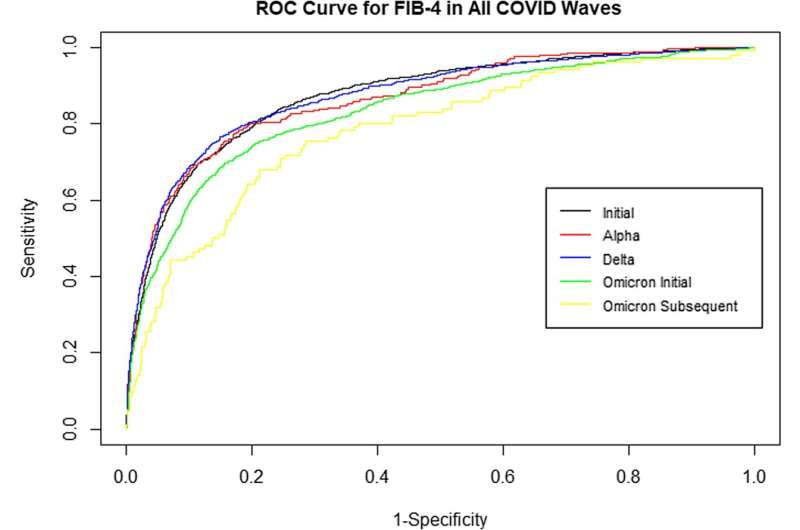This article has been reviewed according to Science X's editorial process and policies. Editors have highlighted the following attributes while ensuring the content's credibility:
fact-checked
trusted source
proofread
A tool in battling COVID: Simple liver test is highly predictive of a patient's need for a respirator

A simple, widely used test developed by a Virginia Commonwealth University researcher to predict advanced liver disease can also predict which COVID-19 patients might need a respirator, with patients higher on the scale almost twice as likely to need help to breathe.
In an article published in the Journal of Clinical and Translational Science, VCU researchers report their analysis of more than 232,000 hospitalized adults across the country who tested positive for the COVID-19 virus. Regardless of the variant of the virus, patients with higher levels on the FIB-4 index were more likely to end up on a respirator.
Patients infected with the initial SARS-CoV-2 virus that sparked the COVID pandemic have a higher rate of respiratory failure, but recent variants are less likely to lead to hospitalization. Studies earlier in the pandemic hinted that the Fibrosis-4 index might also help evaluate COVID-19 patients. This new analysis dives deeper, exploring the role of the FIB-4 index in understanding risk factors and guiding treatment decisions over the COVID-19 variants.
"FIB-4 stands the test of time" and continues to find new applications, said Richard Sterling, M.D., chief clinical officer of VCU's Stravitz-Sanyal Institute for Liver Disease and Metabolic Health, the lead for clinical and translational science pilot programs at VCU's C. Kenneth and Dianne Wright Center for Clinical and Translational Research, and the study's corresponding author.
By incorporating measurements such as a patient's age, liver enzymes and platelet count, the FIB-4 index can judge the severity of a patient's liver disease. In the early 2000s, Sterling developed the index, now considered the gold standard worldwide as the initial screening test for most liver diseases. The FIB-4 is a simple test recommended by leading liver, gastroenterology and endocrinology societies as a first-line test to screen for liver fibrosis.
The analysis in the current study sought to determine whether the FIB-4 index would be a useful tool related to newer variants of the coronavirus, including alpha, delta and the more recent omicron. The researchers reviewed data on 232,364 hospitalized patients, ages 18–90, who tested positive for COVID-19 between April 27, 2020, and June 25, 2022, as part of the National COVID Cohort Collaborative.
The primary objective was to investigate the association between the FIB-4 index and the need for respiratory support, which often precedes a patient's death. Additionally, the study explored the relationship between index measurements and the likelihood of a patient's death within the first 30 days after falling ill.
The FIB-4 index was notably accurate, particularly during the wave of the delta variant, when the index had a 97% success rate in predicting those who would not need respiratory support and strongly associated in those who would.
Overall, regardless of the COVID-19 variant, patients with increased FIB-4 levels were 1.8 times more likely to require a respirator to breathe for them.
Even when adjusting for other health factors like diabetes, cardiac issues, respiratory disease and obesity, the FIB-4 index's reliability remained valuable in differentiating between patients with multiple illnesses who may require respirators and those who are less likely to need such intervention.
The power of the FIB-4 index also helped predict whether patients would survive more than a month. Patients across the different virus variants who had elevated FIB-4 levels faced an increased risk of dying within 30 days after falling ill. (The review found that 25,250 patients died in that period.) This implies that the FIB-4 index serves as a holistic indicator of a patient's overall health and prognosis.
As the COVID-19 pandemic continues, and as the virus evolves in transmissibility, severity, symptoms and response to vaccines, the FIB-4 index has emerged as a valuable tool for understanding patients' risks for future variants and as a simple tool for front-line providers to help risk-stratify respiratory disease severity from COVID-19.
More information: Priyanka Parajuli et al, Fibrosis-4 (FIB-4) index as a predictor for mechanical ventilation and 30-day mortality across COVID-19 variants, Journal of Clinical and Translational Science (2023). DOI: 10.1017/cts.2023.594

















